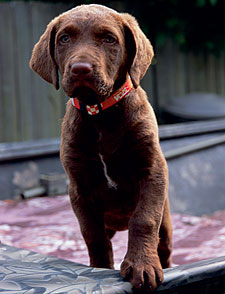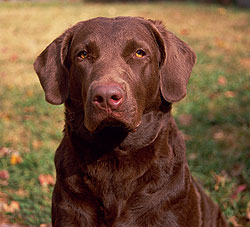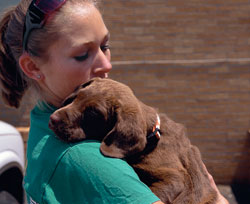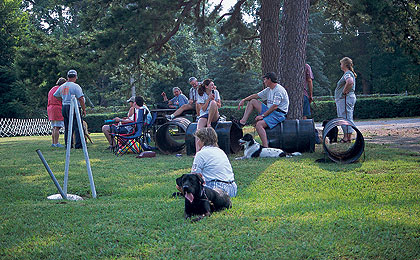Nearly 14 years had passed since we last had a puppy in our house. This time, my wife lobbied for a dog she could hold on her lap. She was rewarded with a Chesapeake Bay retriever that would love nothing more than to oblige. Big difference!
By Gary Koehler
 From this€¦ |
The fix was in from the beginning. I had driven more than 500 miles from southwest Tennessee to the village of Tiskilwa in north-central Illinois. En route to the Chicago suburbs on business, I had taken a detour to stop and check out a litter of Chesapeake Bay retriever puppies. Don and Paula Smith, the owners/breeders, were waiting at their front door.
Led through their home into a fenced backyard where the puppies were sequestered, I had no sooner set a foot on the grass than I felt something tugging at my shoelace. The source of the commotion was a brown ball of mischief and innocence, eyes sparkling, tail wagging, radiating both energy and charm.
"That's the one, the female that you asked about on the phone," said Paula Smith, somehow managing a straight face. "I guess she found you before you found her."
There were a half-dozen puppies from which to choose, those remaining from a litter of 11, including a stocky bruiser the Smith's called "Goliath," the runt, and three others, all males. Then there was this bewitching female at my feet, who quickly moved on to other business, most notably pulling leaves off assorted tiger lilies lining a wooden fence.
 €¦to this in just one year. |
I talked with the Smiths about the puppies' parents, Remi, the bitch, and Gunner, the sire, both of which were on the premises. More than anything else, I wanted to gauge their temperament and their demeanor toward strangers. I never before owned a Chessie. And, like everyone else, I had heard stories about the breed's alleged aggressive behavior.
"They're babies," Don Smith said of Remi and Gunner. "Until we go duck hunting." I asked the Smiths to let Remi and Gunner out of their kennel run. The dogs did not so much as look at me, let alone do anything threatening, even though I was picking up each of their puppies and inspecting them one at a time. While I was leaning toward a female, the males were too handsome to pass up without a closer look.
One in particular struck my fancy. But the pesky female was back again, scratching at my pant leg.
Four days later, after completing my business, I returned to Tiskilwa. The Smiths' daughter was sitting on the living room sofa, a female Chessie pup asleep on her lap. I felt terribly guilty when I packed that puppy in a battered crate and loaded her into the car. But this one was mine. I named her Kayla. She was to become my duck dog.
 Kimberly, the author's daughter, and Kayla enjoy some quality time. |
The next day, it took Kayla all of 10 minutes to capture my wife's heart. The pup went to her immediately, demanding to be hugged. "Hi, cutie," my wife said to the squirming pup at her feet. I was stunned. We had a German shorthaired pointer for 12 years. Nick was called many things during his tenure, but "cutie" was never one of them.
Training Kayla
Training began that evening. Chessies, so said all of the books, do much better when kept inside, with their owners. So potty training was job one. Kayla apparently enjoyed my picking her up, cradling her under one arm and rushing her to the backyard whenever she looked like she had to go. "Out," I'd say. And off we'd run. Again, and again, and again.
Vigilance is the key here. This is a lesson in repetition. There were a few accidents. But within 10 days, Kayla was 95 percent housebroken.
After two weeks of adjusting to her new home and bonding with family members, the most basic of training began, going slow and easy. Kayla recognized her name and she quickly learned what "eat" meant. She was instructed to "sit" before being given her food. If she did not sit, the bowl was put up until she did. This command was reinforced during the evenings when she was with us in the living room. Sitting on command resulted in a treat.
From sit, we went to "come," which was reinforced with a collar and leash. That was followed by "sit/stay, down, heel and no." She enjoyed learning. And pleasing us. Did she have a mind of her own as a pup? Oh, yeah. And that's still present. From time to time, she is not shy about letting us know when she wants to go out, or move from my office into the living room, for that matter. A tug on my shirtsleeve is her way of getting across her message. We're still working on that.
While basic obedience can be taught at home, I am convinced that attending a structured training class paid huge dividends. At five months of age, we enrolled Kayla in two consecutive eight-week programs, with classes being held for one hour once a week. A record book was provided by the class instructors for the purpose of logging what exercises we accomplished during our at-home training sessions and how Kayla performed each one.
Perhaps this became an accountability issue: I never wanted to go to class with an empty page. We practiced the basic drills every day, rain or shine, either inside or out. After some initial apprehension, Kayla enjoyed the obedience class interaction with other dogs involved, most of whom, at this point, were larger than she was.
Socialization with humans was also vigorously pursued. I brought Kayla into my office at least one day a week for eight straight weeks. Early on, she napped under my desk--except when she was being carried around the building and otherwise played with by co-workers.
She learned that people we
re nice--friends. Long walks in the park and around the neighborhood resulted in plenty of contact with both adults and children--all good stuff for an impressionable pup.
Of course, there were bumps along the training trail. Plenty of them. I'll take the blame for causing my share. Foremost, I learned that one must clearly let the dog know what you want it to do. Do not assume the dog knows anything. Go slow. And build on successes. Still, you will sometimes become frustrated.
Kayla hit a stretch right around 15 months of age where it seemed that everything she had learned had been wiped from her memory. She would do, perhaps, half of what was asked of her. And then quit. Bored? Maybe. Extraordinarily hot weather had something to do with her behavior, I'm sure. But we plugged along, shortening training sessions accordingly. Within a month or so, she came back around.
As far as the how-to aspects of introducing your dog to the gun, working it on blind retrieves, force-fetching, incorporating an electronic collar, teaching it not to break, whistle work and myriad other training considerations, I am not an expert and will not discuss my approach here.
 The author found that Kayla benefited from structured obedience classes and time spent in the park with other dogs and their owners. |
Who wants to follow the advice of a rank amateur when it comes to the technical stuff? Instead, pick up some books or videos, talk with a professional trainer or visit the Internet dog training Web sites. I checked out all of those sources to acquire valuable information.
My purpose here is to give the average person who might be considering purchasing a retriever insight into some of the things that he or she might be wise to remember while striving to instill manners and bidability in what my case turned out to be an extremely powerful 90-pound animal. Dainty, Kayla ain't.
She is, however, relatively well-behaved, a fact that was confirmed at the vet's office recently when an experienced kennel helper told me Kayla was "the smartest dog I've ever had back there." Probably not. But she does listen, even when I'm not around to control her, and that is extremely important.
Hunting season just got under way in our region. So the jury is still out on how Kayla will respond in the field, and if the hours and hours of training paid off. One can never be sure. What I do know is that matching an amateur trainer with a Chesapeake can provide myriad results. In this case, best friends.






